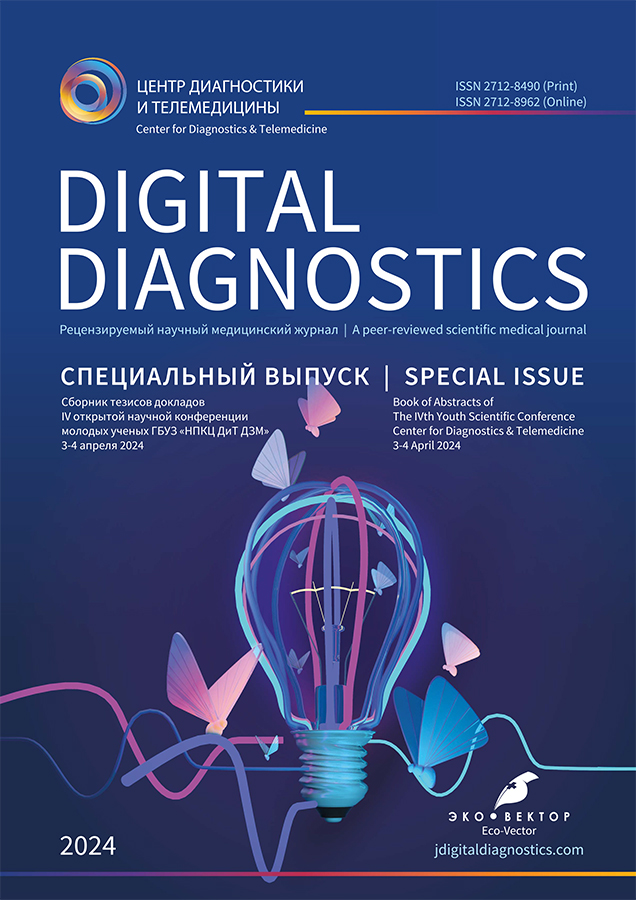Changes in the functional connections of the brain at rest in patients with acute ischemic stroke and hypersomnia
- 作者: Trushina L.I.1,2
-
隶属关系:
- V.A. Almazov National Medical Research Center
- Pskov Regional Clinical Hospital
- 期: 卷 5, 编号 1S (2024)
- 页面: 157-159
- 栏目: 青年科学家的文章
- ##submission.dateSubmitted##: 15.02.2024
- ##submission.dateAccepted##: 13.03.2024
- ##submission.datePublished##: 03.07.2024
- URL: https://jdigitaldiagnostics.com/DD/article/view/627000
- DOI: https://doi.org/10.17816/DD627000
- ID: 627000
如何引用文章
全文:
详细
BACKGROUND: Brain damage after ischemic stroke results in changes in a wide range of structural and functional brain networks [1]. Scientific studies show that although stroke is primarily a focal lesion, it also affects the functional connectivity of anatomical and functional regions, often resulting in altered integration of brain networks and affecting whole-brain function, leading to cognitive and emotional impairment [2, 3].
AIM: The aim of the study was to determine changes in functional brain connectivity during hypersomnia in patients with acute ischemic stroke.
MATERIALS AND METHODS: A total of 44 patients with acute ischemic stroke were examined. The participants were divided into two groups based on the presence of sleep disorders. Group 1 included 22 patients with hypersomnia, which was objectively confirmed by polysomnography. Group 2 also included 22 patients who did not have sleep disorders and constituted the control group. The age of patients in both groups ranged from 45 to 65 years.
All patients underwent magnetic resonance imaging on tomographs with a magnetic field induction strength of 1.5 Tesla, using the standard protocol and special pulse sequences of T-gradient echo 3D MPRAGE and BOLD. Resting-state functional magnetic resonance imaging of the brain was employed to assess functional connectivity. Postprocessing was conducted on specialized software, CONN-TOOLBOX, which generated appropriate graphical representations of quantitative results based on the selection of zones of interest.
RESULTS: In patients experiencing the acute phase of ischemic stroke, hypersomnia results in the strengthening of functional connections, predominantly in the temporo-occipital and parietal regions. This may be associated with impaired visual perception, memory, and spatial orientation. Additionally, there is a weakening of functional connections in the frontal and occipital cortex, which may indicate confusion of thinking and disorders of speech, arbitrary movements, and the regulation of complex behaviors.
The disruption of the functional connections between the medial prefrontal cortex and the posterior cingulate cortex and the cerebellum is indicative of impaired coordination and regulation of balance and muscle tone. However, it also has the potential to affect emotional, cognitive, and behavioral changes in the brain.
CONCLUSIONS: Resting-state functional magnetic resonance imaging is a technique that allows for the determination of changes in functional brain connections during hypersomnia in patients with acute ischemic stroke. Additionally, it enables the identification of neuroimaging markers corresponding to this pathology.
全文:
BACKGROUND: Brain damage after ischemic stroke results in changes in a wide range of structural and functional brain networks [1]. Scientific studies show that although stroke is primarily a focal lesion, it also affects the functional connectivity of anatomical and functional regions, often resulting in altered integration of brain networks and affecting whole-brain function, leading to cognitive and emotional impairment [2, 3].
AIM: The aim of the study was to determine changes in functional brain connectivity during hypersomnia in patients with acute ischemic stroke.
MATERIALS AND METHODS: A total of 44 patients with acute ischemic stroke were examined. The participants were divided into two groups based on the presence of sleep disorders. Group 1 included 22 patients with hypersomnia, which was objectively confirmed by polysomnography. Group 2 also included 22 patients who did not have sleep disorders and constituted the control group. The age of patients in both groups ranged from 45 to 65 years.
All patients underwent magnetic resonance imaging on tomographs with a magnetic field induction strength of 1.5 Tesla, using the standard protocol and special pulse sequences of T-gradient echo 3D MPRAGE and BOLD. Resting-state functional magnetic resonance imaging of the brain was employed to assess functional connectivity. Postprocessing was conducted on specialized software, CONN-TOOLBOX, which generated appropriate graphical representations of quantitative results based on the selection of zones of interest.
RESULTS: In patients experiencing the acute phase of ischemic stroke, hypersomnia results in the strengthening of functional connections, predominantly in the temporo-occipital and parietal regions. This may be associated with impaired visual perception, memory, and spatial orientation. Additionally, there is a weakening of functional connections in the frontal and occipital cortex, which may indicate confusion of thinking and disorders of speech, arbitrary movements, and the regulation of complex behaviors.
The disruption of the functional connections between the medial prefrontal cortex and the posterior cingulate cortex and the cerebellum is indicative of impaired coordination and regulation of balance and muscle tone. However, it also has the potential to affect emotional, cognitive, and behavioral changes in the brain.
CONCLUSIONS: Resting-state functional magnetic resonance imaging is a technique that allows for the determination of changes in functional brain connections during hypersomnia in patients with acute ischemic stroke. Additionally, it enables the identification of neuroimaging markers corresponding to this pathology.
作者简介
Lidiya Trushina
V.A. Almazov National Medical Research Center; Pskov Regional Clinical Hospital
编辑信件的主要联系方式.
Email: lidabondarenko@yandex.ru
ORCID iD: 0000-0001-6198-8583
俄罗斯联邦, Saint Petersburg; Pskov
参考
- Salvalaggio A, De Filippo De Grazia M, Zorzi M, Thiebaut de Schotten MT, Corbetta M. Post-stroke deficit prediction from lesion and indirect structural and functional disconnection. Brain. 2020;143(7):2173–2188. doi: 10.1093/brain/awaa156
- Xu X, Tang R, Zhang L, Cao Z. Altered Topology of the Structural Brain Network in Patients With Post-stroke Depression. Front Neurosci. 2019;13:776. doi: 10.3389/fnins.2019.00776
- Koch G, Bonnì S, Casula EP, et al. Effect of Cerebellar Stimulation on Gait and Balance Recovery in Patients With Hemiparetic Stroke: A Randomized Clinical Trial. JAMA Neurol. 2019;76(2):170–178. doi: 10.1001/jamaneurol.2018.3639
补充文件













